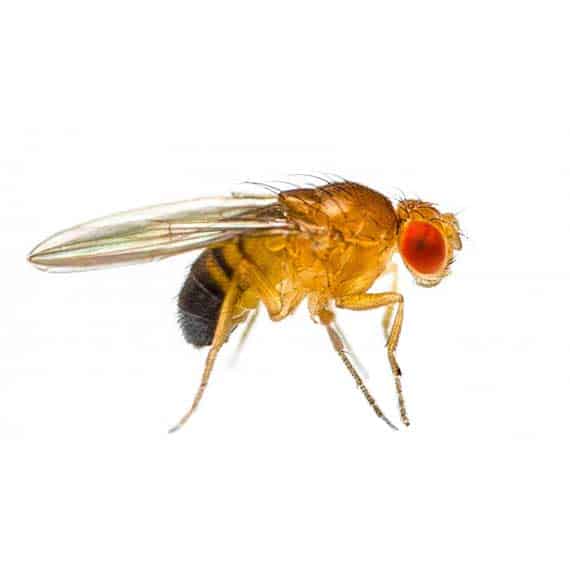
Drosophila is commonly considered a pest due to its tendency to infest habitations and establishments, where fermenting fruit is found; the flies may collect in homes, restaurants, stores, and other locations. Removal of an infestation can be difficult, as the larvae may continue to hatch in nearby fermenting fruit even if the adult population is eliminated.
Physical Description: Fruit flies are very small insects, ranging from 2-4 mm in length. They have red eyes, yellow-brown bodies, and some darker black markings on their abdomen. Their wings are clear with several dark bands across them.
Lifecycle: The total lifecycle ranges from 8-10 days. Eggs are laid near the surface of fermenting foods or other moist organic materials. Larvae hatch in 1-3 days, feed for 5-6 days, then pupate for approximately 2 days before emerging as adults. Adults live for about 8 days.
Feeding: Fruit flies feed on decaying fruits, vegetables, and other fermenting organic materials. They are particularly attracted to ripened produce and alcohol.
Breeding: Females lay eggs near moisture and food sources. Larvae develop best in wet, decaying matter. Ideal breeding sites include drains, trash bins, compost piles, and mops or sponges.
Activity: Fruit flies are most active during the daytime in warm weather conditions. In temperate regions like Winnipeg, populations boom in late summer and early fall when ripe fruits become abundant. Their activity drops in the winter.
Seasonal Increase: Fruit flies multiply quickly in late summer and autumn in Winnipeg when fruits ripen and begin decomposing. Homegrown and store-bought produce provides ample breeding sites during these months.
Health Concerns: Although they do not bite, fruit flies can transmit bacteria and fungi from rotting matter to food preparation surfaces. This raises risks of food contamination and illness.
Economic Impact: Businesses dealing with produce, such as grocery stores, restaurants, and cafes are most affected by seasonal fruit fly infestations. They can harm operations and lead to inventory losses.
Food Sources: Overripe fruits and vegetables, fermenting liquids, compost piles, recyclables, trash bins.
Breeding Grounds: Drains, sink overflow holes, cleaning mops and sponges, trash containers.
Entry Points: Small openings around windows and doors, gaps in screens, vents, plumbing pipes. Fruit flies easily fly inside whenever doors open.
Sanitation: Eliminate breeding sites by cleaning drains, taking out trash regularly, and wiping up spills. Avoid leaving produce and compost exposed.
Exclusion: Seal gaps and install tight screens on doors and windows. Use air curtains over entrances in food establishments.
Natural Remedies: Traps with apple cider vinegar or wine work well. Keep outdoors to prevent more flies from entering.
Chemical Solutions: In severe cases, applying a residual insecticide to breeding areas can kill emerging adults. Use caution and strictly follow label directions.


